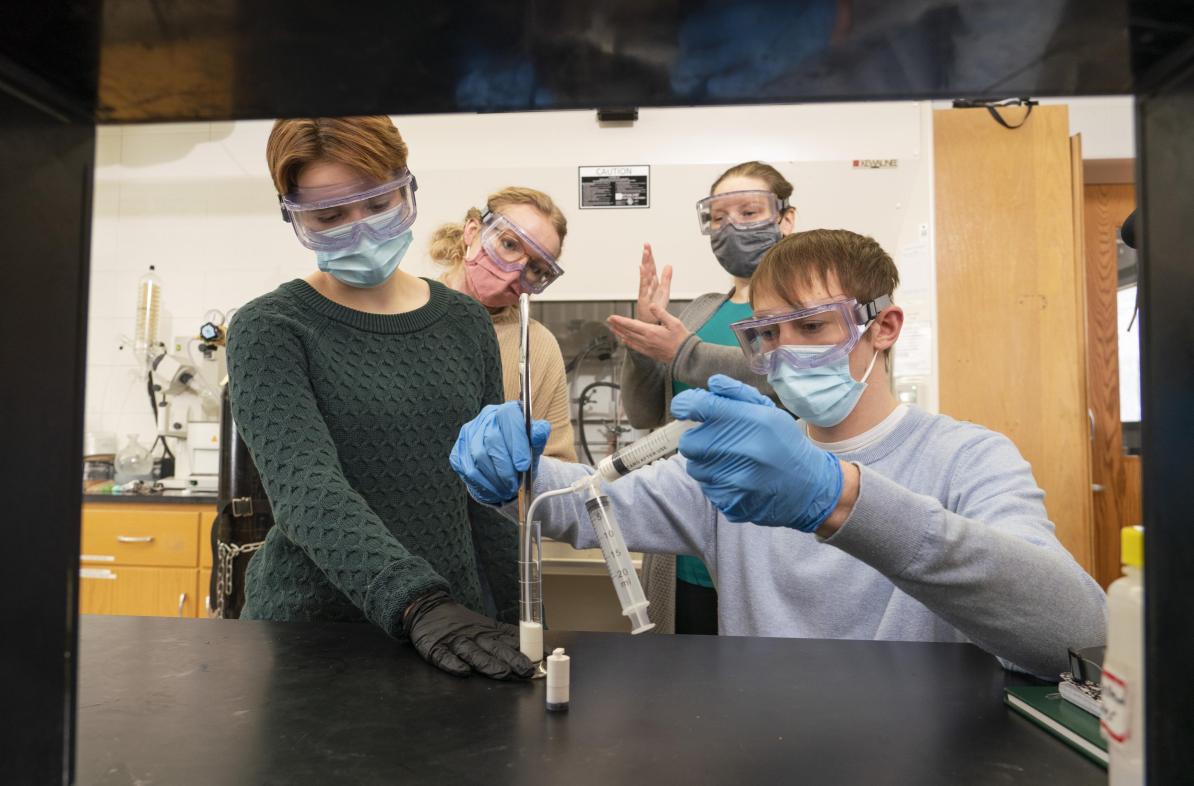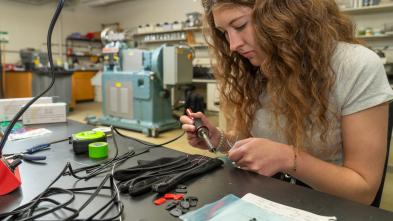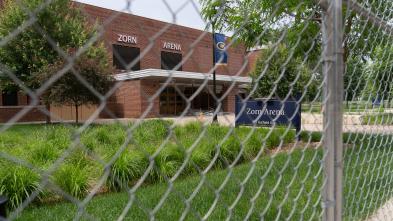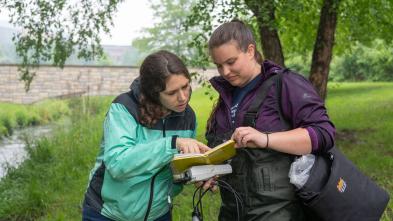
Blugolds to present research at prestigious Posters on the Hill event in nation's capital
A team of undergraduate students at the University of Wisconsin-Eau Claire will share their research with a national audience this spring during the prestigious Posters on the Hill event in Washington, D.C. Just 60 projects were selected for the event.
The students will present their research, “Biocompatible Foam in Tumor Treatment for Improved Patient Recovery,” at the National Council on Undergraduate Research’s annual research event, which will be held virtually April 26-27. NCUR selects just 60 projects out of hundreds of applicants from colleges and universities across the country to be featured in Posters on the Hill.
“It’s a really big deal,” Kira Haus, a biomedical engineering major, says of being selected to be part of the highly competitive event that takes place in the nation’s capital each year. “It’s hard to wrap my brain around it. We are just so excited.”
The student researchers include Haus, a sophomore from Elk River, Minnesota; Marshall Apps, a sophomore biochemistry/molecular biology major and Spanish minor from Green Bay; and Grace Cunningham, a freshman from Maple Plain, Minnesota, who is a chemistry major with an emphasis in biochemistry, in the pre-med program and is earning a certificate in American Sign Language.
Their research mentors are Dr. Elizabeth Glogowski, an associate professor of materials science and biomedical engineering at UW-Eau Claire, and Dr. Jeremy McBride, a doctor of vascular and interventional radiology at Mayo Clinic Health System in Eau Claire.
Glogowski says presenting at Posters on the Hill is a “unique and great opportunity” for students to share their research and its impact with a national audience. The students earned their place at the event through hard work and a willingness to “embrace every opportunity,” she says.
“Without having any previous experience in research, they jumped in enthusiastically, learned the techniques for making foam, recording scientific data, analyzing that data, and presenting their results to audiences from general audiences to top medical professionals from Mayo Clinic,” Glogowski says of the student researchers, all first- or second-year undergraduate students. “I’m enjoying seeing them grow into confident researchers who can discuss their results with PhD's and M.D. professionals.”
The Blugolds already have presented their research to the campus community and to health care professionals in Eau Claire and Rochester, Minnesota. It’s a “humbling, cool experience” to now be invited to discuss their research and findings with legislators and other government officials, Apps says, adding that he never expected to have these kinds of experiences as an undergraduate student.
Cunningham, who joined the research team in the fall, says it’s surreal to be just months into her undergraduate college career but already be doing medical research with real-life implications. That she gets to present the research to a national audience makes it even more incredible, she says.
“It means a lot that other people see that our research is meaningful, and that people at a national level are excited enough about it to be saying ‘tell us more,’” Cunningham says.
Real-world medical research
Since 2019, McBride, Glogowski and UW-Eau Claire student researchers have been working to develop an injectable biologic foam used to protect healthy tissues from being damaged when cancer patients are receiving a particular kind of treatment.
They have successfully generated foams for use during tumor ablation procedures and completed lab testing to optimize foam stability and how they may insulate healthy tissue from the high heat generated during the ablation procedure, Glogowski says. McBride also has completed in vivo studies to confirm the nontoxic properties of the foam, and that the foam does protect healthy tissue, she says.
They now are working to patent the material and the process before publishing their work, Glogowski says, adding that the research team also is working to gain approval for human trials.
“Knowing it has the potential to positively impact people's lives, and possibly be incorporated into known procedures, makes me realize how important research is and the wonderful significance that it can have within the medical field,” says Apps, calling being part of the project an “amazing opportunity.”
The project’s success reflects what is possible when experts from UW-Eau Claire and Mayo Clinic Health System work together — and involve ambitious and talented undergraduate students — to solve real-world medical problems, Glogowski says.
“Collaboration is what drives this project,” Glogowski says. “Dr. McBride brings his medical knowledge and creativity, and I bring the materials science knowledge and student mentoring. Together, we help students clearly see the connection from what they learn in their coursework, to the experiments they do in the lab, to how that will benefit patients by potentially decreasing pain post procedure.”
Glogowski credits Dr. Tim Nelson, director of research and innovation for Mayo Clinic Health System and a UW-Eau Claire alumnus, for making it possible for “these two big institutions to bring scientists and doctors together to do research and try new things.”
The UW-Eau Claire-Mayo Clinic Health System collaboration makes an already extraordinary research experience even better, say Apps and Cunningham.
“It’s fascinating to hear Dr. McBride’s side of how our research is being tested and, ultimately, how it can be used in interventional radiology procedures,” says Cunningham, who plans to go to medical school after graduating from UW-Eau Claire.
Apps, who also plans to go to medical school, agrees, saying that McBride challenges the students to think creatively and helps them better understand how their work in the lab will impact future patients.
“It’s really cool to talk to Dr. McBride because he can share his medical perspective and tell us exactly how the foam will be used,” Apps says. “Dr. McBride tells us things we didn’t think of, asks us questions and gives us new ideas. That really changes the whole experience.”
Glogowski and McBride are “amazing mentors” who help students gain skills and confidence as well as an understanding of how their work in the lab can impact people’s lives, Haus says.
“They’ve shown me ways I can use my talents and skills and apply them in the lab,” Haus says. “Dr. Glogowski taught me how to present data and talk to people about our research. When I get frustrated, she pulls me back and helps me to see the big picture. Dr. McBride is a creative person who has all these great ideas. It’s incredible that we get to work with them both.”
Cunningham says that because of this research experience, she now is interested in physician-scientist programs so she can continue to focus on medical research while working as a physician.
“Because of this research, I feel much more confident that I can become a competitive applicant to medical programs, and I have a better idea of what I’m interested in,” Cunningham says. “I think the education in being curious and problem-solving that we get from research is probably the most useful takeaway that will help me reach my goals of a career in medicine. “
The students say Glogowski is a wonderful research mentor, guiding them as they joined her research team just months after high school with no experience in a college lab. Among other things, she’s taught them the importance of teamwork and communication, they say.
“She’s been very supportive in guiding and teaching us as new researchers, and in pushing us out of our comfort zones to try things ourselves and to try again if we fail,” Cunningham says. “My fellow research students also teach me so much and are really supportive — we learn with and from each other.”
Blugold Biomedical Innovator Scholars
All the students on Glogowski’s research team are Blugold Biomedical Innovator Scholars, a program established at UW-Eau Claire by Mayo Clinic Health System for students who intend to pursue a degree and career in the health care or biomedical fields.
Student scholars are involved in medical research beginning their freshman year and have job shadowing and other opportunities to interact with medical professionals at Mayo Clinic Health System. The scholarship monies they receive allow them to focus on their research and coursework.
“I came in as a first-year student and immediately started working in research that involves Mayo Clinic Health System, and I have access to a support system of peers and mentors to guide me,” Cunningham says. “It’s already enriched my time at UWEC. Soon I will shadow physicians, so I’ll get a firsthand view of different aspects of health care. I am developing so much as a student and a scientist, and I feel excited and enabled to pursue my goal of medicine as a career.”
Apps says the program is shaping his undergraduate career, giving him “rewarding and really thought-provoking” experiences, including opportunities to interact with physicians in various specialty areas. Since he’s not yet decided on a path he hopes to follow within medicine, shadowing doctors is a great way to learn more about areas that might interest him, he says.
Having access to on-campus mentors and Mayo Clinic Health System doctors has “made a goal that seemed so far off seem like something I can work toward,” Cunningham says of her plans to become a doctor. “I can start thinking about applying to medical school and know I’m a viable candidate.”
Haus also says the Blugold Biomedical Innovator Scholars program is helping her find her future path.
“I’m so thankful for this opportunity that allowed me to discover what I’m passionate about, what I care about and what I want to do with my life,” Haus says. “Being involved in research and development has shown me that this is what I want to do. I love this lab setting where I can do experiments, work with people and collaborate all the time on projects. I know this is the kind of work I want to do.”
In addition to Haus, Cunningham and Apps, Glogowski’s research team now also includes Drew Smith, a freshman biomedical engineering major who is in the pre-medicine program. Smith, who joined the research team in January, says the Blugold Biomedical Innovator program was “the deciding” factor in her coming to UW-Eau Claire.
“It’s an opportunity you can’t pass up,” says Smith, a native of Morris, Illinois. “It’s absolutely a one-of-a-kind opportunity. Just getting to participate in research like this as a freshman is incredible, but also getting to consult with Mayo Clinic physicians is wonderful and amazing.”
Smith says Glogowski gives the student researchers guidance but “we’re creating our own experience and she really wants us to take the project into our own hands.”
“To be independent in the lab has been a fantastic learning experience,” Smith says. “We do labs for classes, but the procedure is written out and given to you. For this, you create your own brand-new procedure. It’s just been so cool. I had absolutely no idea I would be doing this in college, especially in my first year. I’m so grateful and so excited to see where it’s going.”
While she joined the project after the abstract was submitted for Research on the Hill, Smith is thrilled that her research partners will showcase their project during the Posters on the Hill event.
“I had no idea what I was walking into and how well this project was going,” Smith says. “It’s all so completely unexpected and exciting. I hope to help move it forward and advance it even further.”
Haus, now in her second year with the project, says it’s still hard for her to believe that the experiences she’s having at UW-Eau Claire are real.
“Every day gets better, and every day I discover more about the project and myself,” Haus says. “If I could tell my high school self what I would be doing in two years, I’d be amazed — though I don’t think I’d believe it. It’s just an insane opportunity to be part of this research team.”
You may also like


